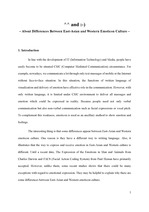

-
미리보기
소개
동아시아(한국, 중국, 일본)와 서양(라틴 알파벳 문화권, 러시아)의 이모티콘 차이를 얼굴 표정 읽기 차이에 기반하여 분석한 레포트입니다.목차
1. Introduction
2. What is Emoticon?
3. East-Asian Emoticon
3-1. Korea
3-2. Japan
3-3. China
4. Western Emoticon
4-1. America (Countries Using Latin-Alphabet)
4-2. Russia
5. Reasons of the Differences
5-1. The Way of Writing
5-2. The Way of Reading Facial Expressions and Emotion
6. Conclusion
Reference본문내용
In line with the development of IT (Information Technology) and Media, people have easily become to be situated CMC (Computer Mediated Communication) circumstance. For example, nowadays, we communicate a lot through only text massages of mobile or the Internet without face-to-face situation. In this situation, the functions of written language of visualization and delivery of emotion have effective role in the communication. However, with only written language, it is limited under CMC environment to deliver all massages and emotion which could be expressed in reality. Because people need not only verbal communication but also non-verbal communication such as facial expressions or vocal pitch.
<중 략>
Most countries using Latin-alphabet have very similar emoticon to American. American emoticon use horizontal images unlike Korean or Japanese which is vertical. In addition, they rarely use shapes such as such as ♥, ★, or ♪ because these shapes are scarcely match with horizontal face emoticons. In particular, they use <3 as ♥. Although some vertical face emoticons are occasionally found in Internet language, American people consider vertical emoticons as typical Asian emoticon.참고자료
· Daum and MSN Instant Messenger. KIISE Workshop Presentation File. pp.87-92
· Du-won Lee, (1995). Theatrical Research of Semiotic Phenomenological Human Communication Model Build. Korean Journal of Journalism & Communication Studies. 35, pp.71-105
· Ji-su Kim, (2003). Research on the Differentiation Between Perceptions of Two Emoticons in
· Myung-jin Kim, (2012). EBS Documentary East and West. 1st ed. : Ji-Sik channel.
· Rachael E. Jack, (2012). Facial Expressions of Emotion are not Culturally Universal. PNAS. 109 (19), pp.7241-7244
· Wikipedia. Paul Ekman. [ONLINE] Available at: http://en.wikipedia.org/wiki/Paul_Ekman. [Last Accessed 07 January 2014].태그
-
자료후기
Ai 리뷰이 자료를 통해 새로운 인사이트와 지식을 얻을 수 있었습니다. 내용이 풍성하여 과제 작성에 큰 도움이 되었습니다. 계속해서 좋은 자료를 기대합니다! 감사합니다. -
자주묻는질문의 답변을 확인해 주세요

꼭 알아주세요
-
자료의 정보 및 내용의 진실성에 대하여 해피캠퍼스는 보증하지 않으며, 해당 정보 및 게시물 저작권과 기타 법적 책임은 자료 등록자에게 있습니다.
자료 및 게시물 내용의 불법적 이용, 무단 전재∙배포는 금지되어 있습니다.
저작권침해, 명예훼손 등 분쟁 요소 발견 시 고객센터의 저작권침해 신고센터를 이용해 주시기 바랍니다. -
해피캠퍼스는 구매자와 판매자 모두가 만족하는 서비스가 되도록 노력하고 있으며, 아래의 4가지 자료환불 조건을 꼭 확인해주시기 바랍니다.
파일오류 중복자료 저작권 없음 설명과 실제 내용 불일치 파일의 다운로드가 제대로 되지 않거나 파일형식에 맞는 프로그램으로 정상 작동하지 않는 경우 다른 자료와 70% 이상 내용이 일치하는 경우 (중복임을 확인할 수 있는 근거 필요함) 인터넷의 다른 사이트, 연구기관, 학교, 서적 등의 자료를 도용한 경우 자료의 설명과 실제 자료의 내용이 일치하지 않는 경우
문서 초안을 생성해주는 EasyAI

